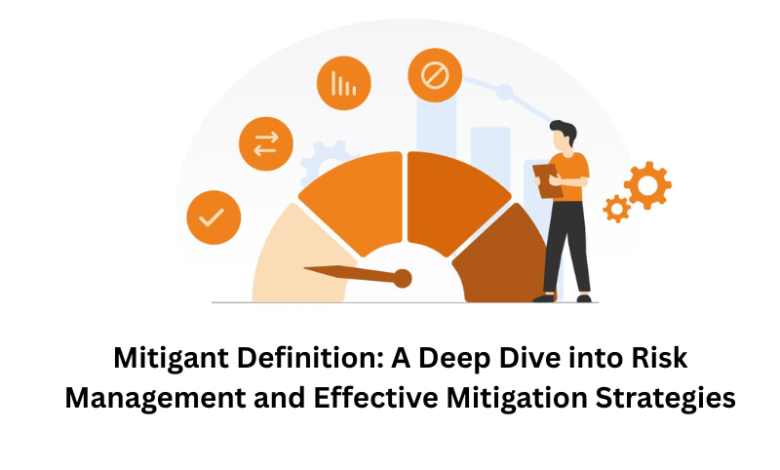Mitigant Definition: A Deep Dive into Risk Management and Effective Mitigation Strategies

In the world of business, mitigating and managing risk and uncertainty is an essential part of the daily operations with regards to the individual level and broader technological spectrum. Every business comes with unique identifying characteristics that bring forth risks such as cybersecurity threats, finance related issues, or even environmental concerns. But businesses need to understand that mitigants help deal with such risks. This guide is aimed in helping the business world understand mitigants and mitigation definitions along with analyzing different types of risks and how to deal with them. In addition, it aims at how to formulate, plan, and quantifiably implement them.
What is a Mitigant?
Anything and everything that can help in lessening and reducing intensity of a certain negative event can be termed as a mitigant. The term mitigant comes from the word mitigate, that has been defined as to lessen or reduce in some capacity. In a simpler manner, all risks of any business can be avoided to some degree and mitigants are a mage of methods that help protect businesses.
Mitigants can be considered as shields in the modern society, whether this happens at an individual or organizational level. For example, if an organization foresees a major risk in the case of cyber attacks, implementing antivirus programs, establishing firewalls, and training employees on how cyber threats work, are all generically referred to as mitigants. In normal consideration, these actions make up the greater risk management plan that is aimed at damage limitation.
Types of Mitigants:
Preventive Mitigants: These include all measures which are designed to ensure a particular risk does not happen, or else, if it does happen, its potential must be minimized. For example, employing encryption techniques to safeguard any sensitive information.
Corrective Mitigants: These include measures taken when the risk event has occurred which are aimed at reducing the level of damage. This might include disaster recovery plans or business continuity strategies.
Compensatory Mitigants: These come into play when primary measures for mitigation fail and there is need to fall back to an alternative strategy. For example, having unbudgeted critical expenditures covered by insurance or reserve emergency funds.
Mitigation Definition: What Does It Mean?
Mitigation means attempting to lessen the severity or history of harm or damages to people, assets or environment. It involves identifying risks, assessing their potential impacts, and implementing measures to limit their potential and reality.
Mitigation, depending on the risk, may take many forms. In an environmental context, mitigation may take the shape of planning for tree planting to help control soil erosion. In business, such as in IT, it may mean implementing measures aiming to prevent breaches.
Mitigation And Risk Management
Mitigation is the keystone of an overarching strategy for risk management. It involves taking preventative actions towards the negative impacts of a multitude of risks. Taking action before risks materialize provides organizations the opportunity to adopt tailored mitigants to avert damage. Quantitative Risk Assessment and Risk Matrices
One key factor in risk mitigation is the ability to estimate the potential impact and likelihood of specific risks. As with multiplying the probability of a risk occurring with the severity of its impact; probability and impact analyses as well as risk matrices help in this regard.
Risks can be assessed based on their probability of occurrence considering two main categories of consequence impact “minor” and “major”. For example, moderate range risks such as cyber-attacks can be assigned numeric values on a scale rating its probability of occurrence and severity of destruction.
These strategies can provide organizations the means to determine the focus of risk and information systems management allocation and where to best apply mitigation measures. In the course of value determination ascribed to risk in expectation form, strategies aimed at risk such as cyber-affectation can be analyzed easily.
Other Detailed Risks And their Specific Mitigation Strategies
Information risks
Information risks concern the risk of causing disclosure of sensitive data such as intellectual property rights of an organization and violation of privacy. With internet expansion, data is easily and mistakenly captured thus causing operational risks. Exposing sensitive aspects of proprietary technology may lead to furiously escalated competition driving price wars.
Daily loss multi-dimensionally degrades value in equation marking multi, value skyrockets.Financial Modeling: Employing data to predict possible outcomes of finances while altering strategies where it is necessary.
Cybersecurity Risks
As for cybersecurity, effective mitigants include but are not limited to:
- Zero Trust Architecture: A model of security that assumes no trust even in a network. Access to extremely confidential systems is continuously verified.
- SIEM: Tools for detecting, monitoring, and responding to an attack in real time.
- Penetration Testing: Cyber attack simulations intended to discover weakness and reinforce them.
Environmental Risks
As for mitigating of environmental risks, consideration can be given:
- Regulatory Compliance: Restricting operations defined by environmental laws or regulations.
- Engineering Solutions: Constructing for extreme forces of nature like floods or earthquakes.
- Sustainable Practices: Changing practices such as waste minimization, water conservation, and utilization of renewable energy sources to lower damage done to the environment.
How to create a risk mitigation plan that covers everything?
An organization to manage risks is to have in place a well designed mitigation risk plan. Follow this to build one:
Risk Identification: Identification of risks is crucial from the perspective of an organization. They can be natural disasters, financial disasters, or cyber threats.
Risk Analysis: Analysis of the likelihood and impact of every risk should be done. This way, it becomes easier to figure out what matters first.
Draft Mitigation Plans: From the risk analysis, identify the right mitigants and implement them. Delegate responsibilities, establish deadlines, and develop tracking systems for monitoring progress towards these strategies.
Tracking and Evaluation: Continually track risks alongside mitigations to evaluate the effectiveness of the controls. Adapt the strategies as needed to address emerging or changing risks.
Back-Up Planning: Some risks may persist after all other measures are taken. It is crucial to account for these lingering threats and devise strategies to mitigate the remaining risks.
Limitations of Mitigation
Even though they are effective, mitigation strategies have their limitations:
Residual Risk: Some level of risk always looms, hence not all risks have the potential to be counteracted, making residual risk exist. It’s the risk that has not been accounted for and needs solid backup plans.
Unfortunate Impacts: Reverse impacts could arise as a result of pursuing the mitigation strategies. Such as becoming overly reliant on technology for cybersecurity, leading to vulnerability in ways the organization could not anticipate.
Cost versus Benefit Analysis: These calculations can also prove counterproductive when trying to save money leading to lack of impact, where the risk outweighs the cost.
Emerging Risk Trends and the Evolution of Risk Management
Risk management like any other field is not stagnant; it adapts as new challenges arise. Some of the risks which pose the biggest threat to contemporary risk management include:
- The Rise of Artificial Intelligence (AI): There are both pros and cons to the rise of AI. Systems may be subject to attacks or algorithms may be biased, presenting unique challenges for mitigation.
- Wildfires, hurricanes, and floods the enemy of Climate Change: The increase of the environmental threats leads to wildfires which adds to the environmental issues which the government has to deal with.
- Globalization: Rising economic conflicts and international tensions brings additional challenges to businesses and adds further risks to those operating within foreign markets.
Staying Compliant within the Boundaries of Risk Control
Compliance is key when integrating these regulations for risk mitigation strategies. Certain laws of the industry (for example GDPR in Europe or HIPAA in healthcare) force the organizations to adhere and follow certain procedures if they want to avoid losses or penalties.
Risk Management in Organizations are Made by People
Human mistakes and the organizational culture have a fundamental impact on risk management. Incredibly well crafted alongside robust mitigation techniques could all fail rapidly if there is insufficient training, or organizational culture is not supportive of managing risks. Organizational risk culture develops through training, top-level engagement, and communication of risks and mitigation strategies.
Final Thoughts: Mitigants and Their Essential Role in Risk Management
As we have seen, mitigants are an important aspect of a risk management approach. They help businesses decrease the chances of encountering certain risks, be it financial or even an environmental crisis. Understanding the mitigation definition, quantifying risks, and formulating specific plans aids businesses in navigating uncertainties, ensuring they not just survive but prosper amidst global turbulence.
Further Reading: Financial Management Explanation: Key Concepts & Practical Insights





